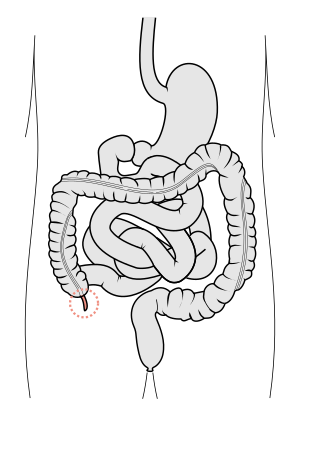Related Research Articles

Appendicitis is inflammation of the appendix. Symptoms commonly include right lower abdominal pain, nausea, vomiting, and decreased appetite. However, approximately 40% of people do not have these typical symptoms. Severe complications of a ruptured appendix include widespread, painful inflammation of the inner lining of the abdominal wall and sepsis.

The appendix is a finger-like, blind-ended tube connected to the cecum, from which it develops in the embryo. The cecum is a pouch-like structure of the large intestine, located at the junction of the small and the large intestines. The term "vermiform" comes from Latin and means "worm-shaped". The appendix was once considered a vestigial organ, but this view has changed since the early 2000s. Research suggests that the appendix may serve an important purpose as a reservoir for beneficial gut bacteria.

Peritonitis is inflammation of the localized or generalized peritoneum, the lining of the inner wall of the abdomen and cover of the abdominal organs. Symptoms may include severe pain, swelling of the abdomen, fever, or weight loss. One part or the entire abdomen may be tender. Complications may include shock and acute respiratory distress syndrome.

An appendectomy or appendicectomy is a surgical operation in which the vermiform appendix is removed. Appendectomy is normally performed as an urgent or emergency procedure to treat complicated acute appendicitis.

McBurney's point is the name given to the point over the right side of the abdomen that is one-third of the distance from the anterior superior iliac spine to the umbilicus (navel). This is near the most common location of the appendix.

Abdominal pain, also known as a stomach ache, is a symptom associated with both non-serious and serious medical issues. Since the abdomen contains most of the body's vital organs, it can be an indicator of a wide variety of diseases. Given that, approaching the examination of a person and planning of a differential diagnosis is extremely important.
Rovsing's sign, named after the Danish surgeon Niels Thorkild Rovsing (1862–1927), is a sign of appendicitis. If palpation of the left lower quadrant of a person's abdomen increases the pain felt in the right lower quadrant, the patient is said to have a positive Rovsing's sign and may have appendicitis. The phenomenon was first described by Swedish surgeon Emil Samuel Perman (1856–1945) writing in the journal Hygiea in 1904.
Blumberg's sign is a clinical sign in which there is pain upon removal of pressure rather than application of pressure to the abdomen. It is indicative of peritonitis. It was named after German surgeon Jacob Moritz Blumberg.

The psoas sign, also known as Cope's sign or Obraztsova's sign, is a medical sign that indicates irritation to the iliopsoas group of hip flexors in the abdomen, and consequently indicates that the inflamed appendix is retrocaecal in orientation.
Valentino's syndrome is pain presenting in the right lower quadrant of the abdomen caused by a duodenal ulcer with perforation through the retroperitoneum.
An acute abdomen refers to a sudden, severe abdominal pain. It is in many cases a medical emergency, requiring urgent and specific diagnosis. Several causes need immediate surgical treatment.
The paracolic gutters are peritoneal recesses – spaces between the colon and the abdominal wall.

Epiploic appendagitis (EA) is an uncommon, benign, self-limiting inflammatory process of the epiploic appendices. Other, older terms for the process include appendicitis epiploica and appendagitis, but these terms are used less now in order to avoid confusion with acute appendicitis.

The Alvarado score is a clinical scoring system used in the diagnosis of appendicitis. Alvarado scoring has largely been superseded as a clinical prediction tool by the Appendicitis Inflammatory Response score.
Markle's sign, or jar tenderness, is a clinical sign in which pain in the right lower quadrant of the abdomen is elicited by the heel-drop test.

The human abdomen is divided into quadrants and regions by anatomists and physicians for the purposes of study, diagnosis, and treatment. The division into four quadrants allows the localisation of pain and tenderness, scars, lumps, and other items of interest, narrowing in on which organs and tissues may be involved. The quadrants are referred to as the left lower quadrant, left upper quadrant, right upper quadrant and right lower quadrant. These terms are not used in comparative anatomy, since most other animals do not stand erect.

Omental infarction, or omental torsion, is an acute vascular disorder which compromises tissue of the greater omentum—the largest peritoneal fold in the abdomen.
Lockwood's sign is a medical sign that indicates Crohn's disease and/or chronic appendicitis. This sign is named after the English surgeon and anatomist, Charles Barrett Lockwood, who stated that:
"The patient lies on his back with his head raised on a pillow and his knees drawn up, so that the superficial abdominal muscles are relaxed. The surgeon sits down near his right side and palpates the right iliac region near McBurney's spot with the three inner fingers of his left hand. If he feels a trickle of flatulence passing his fingers and if this can be often repeated after waiting a half to one minute, or a little longer, the patient has either a chronically inflamed appendix or adhesions near it."
Intra-abdominal infection is a group of infections that occur within the abdominal cavity. They vary from appendicitis to fecal peritonitis. Risk of death despite treatment is often high.
Murphy's triad is a collection of three signs and symptoms associated with acute appendicitis, a medical emergency which presents with lower right abdominal pain, along with nausea, vomiting, and fever.
References
- ↑ Humes, D. J.; Simpson, J. (2006). "Acute appendicitis". BMJ. 333 (7567): 530–534. doi:10.1136/bmj.38940.664363.AE. PMC 1562475 . PMID 16960208.